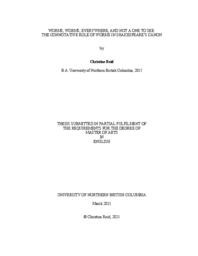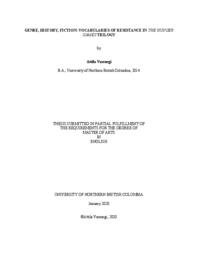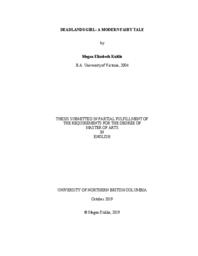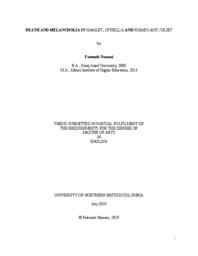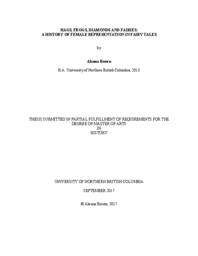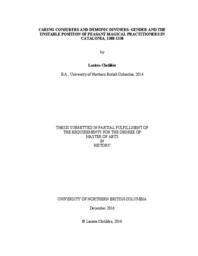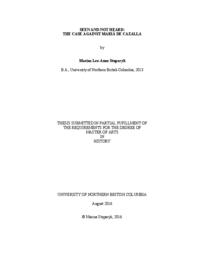Wessell Lightfoot, Dana
Person Preferred Name
Dana Wessell Lightfoot
Related Works
Content type
Digital Document
Description / Synopsis
Every summer thousands of Britain’s elite upper class travelled to London’s West End to socialize and participate in the Season. During this time, elite women donned luxurious court gowns and went to St. James Palace to present themselves before Queen Victoria in Drawing Room ceremonies. One of these gowns, from 1863, survives today and offers an evocative glimpse of how elite women styled themselves for one of the most important ceremonies in their life. But, the West End was not just an elite neighbourhood. It also housed and employed middle and working-class Victorians with whom the elite did not always happily coexist. In 1861, peer and M.P. Sir Shelley allegedly flashed the public and his middle-class neighbours while a carriage procession for one of the Queen’s Drawing Room ceremonies passed below. The Times reported his trial, which featured contemptuous cross-examinations of several working-class women, and Sir Shelley’s triumphant victory. Two years later, several elite men submitted letters to the editor of The Times, complaining about the cramped and sometimes combative atmosphere of royal ceremonies, suggesting that they were not safe for women to attend. There is a gendered conflict in these sources. Those from elite feminine perspectives show the value in attending royal ceremonies, during which women could use their fashion and occupation of space to reinforce or manipulate their social status. The documents written from men’s points of view, however, show an attempted renegotiation of elite status by excluding the middle class and further limiting women’s access to elite spaces. My research questions where this conflict originated and how historians can utilize less traditional sources to bring feminine perspectives into areas of history in which male points of view have often dominated.
Origin Information
Content type
Digital Document
Description / Synopsis
The study of animals in Shakespeare’s collected works has expanded over the last 30 years. While a number of different animals have been discussed, the importance of the worm in the larger scope of the canon has largely been ignored. By focusing on the perception and presentation of worms in relation to cultural ideas of death, corruption, and consumption, ideas surrounding the body and soul are brought to the forefront. Worms are integral to our understanding of the Early Modern cultural constructs of the body and soul as the presence of worms reveals the state of the individual or the broader environment. Overall, the depiction of worms in Shakespeare’s works serves as a way to understand the metaphysical processes surrounding death and corruption.
Origin Information
Content type
Digital Document
Description / Synopsis
This thesis examines Suzanne Collins‘ use of “arena fiction” conventions and historical social reform movements in The Hunger Games trilogy (THG) to encourage reflection on the means of subverting the intended effects of spectacle, but also to consider the cost of consuming or using children in social reform. My thesis argues that THG is an arena story which explores the mechanics of social reform through powerful visuals while also exploring the personal cost, especially on children, of becoming a visual symbol of resistance. I show how THG is rooted in historical social reforms and why these are so useful for Collins to generate visual resistance literacy in her readers and push her use of arena fiction deeper into exploring child bodies. Finally, through a close reading of the subversions in THG, I argue that Collins uses both arena fiction and history to further reflection on children‘s participation in reform movements.
Origin Information
Content type
Digital Document
Description / Synopsis
Deadlands Girl is a short young adult, fantasy fiction novel set in a post-apocalyptic Canada. The protagonist, Tabitha, is kidnapped and brought to Faerie and the novel follows her quest to come back home. Written as a response to the notion that there are few non-historical Young Adult (YA) novels that are set in Canada, my creative thesis demonstrates that a novel can explore themes of identity, belonging and power while using the Canadian landscape as a backdrop and an inspiration. Mythological creatures assist Tabitha on her hero-quest but, ultimately, it is a coming-of-age story about a young woman growing up and discovering her own power. The novel is introduced with a critical analysis of young adult fiction in Canada, a discussion of identity and what it means to be a Canadian writer creating dark, but hopeful, stories for youth.
Origin Information
Content type
Digital Document
Description / Synopsis
This thesis analyzes the effects of love and melancholia on male and female characters along with their responses to melancholia which fluctuate among choler, revenge, murder, suicide, homicide, madness, never-ending mourning, and lovesickness in Hamlet, Othello, and Romeo and Juliet. My analysis draws on a composite theoretical framework that combines new historicist or cultural materialist perspectives and psychoanalytic approach, focusing on Sigmund Freud’s conceptualization of mourning and melancholia and Julia Kristeva’s meditations on depression and melancholia. Having examined these three plays in terms of their creative symptomatology revealed in the characters’ melancholic dispositions––thus viewing Shakespeare as creative symptomatologist, I arrived at establishing a range of gendered melancholic states, namely love melancholia, virgin melancholy or greensickness, and choleric melancholia. Furthermore, while in Shakespearean dramatic universe the cure for individual melancholia is administered, stereotypically, through marriage and sex,
Origin Information
Content type
Digital Document
Origin Information
Content type
Digital Document
Origin Information
Content type
Digital Document
Origin Information


